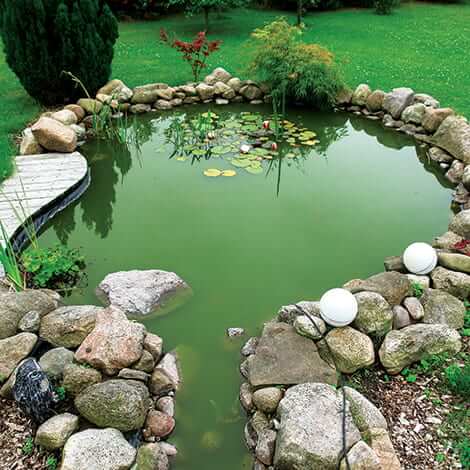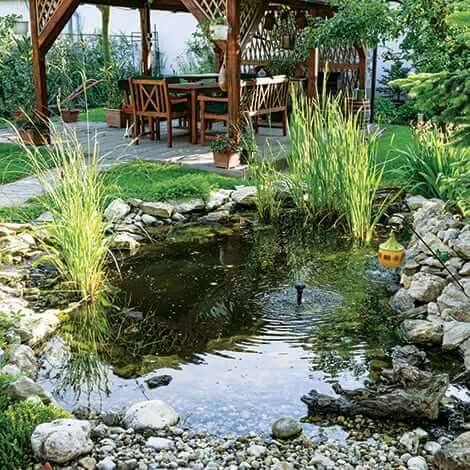Last Updated: April 9, 2024
There’s nothing worse than watching your pond turn green or seeing buildup on your waterfall rocks. If you want to learn how to get rid of algae in your pond, there are several products, both chemical and chemical-free, that can help. In this guide, we'll cover the best pond algae control tips to help keep your pond clean and clear. Most importantly, we'll cover how to get rid of algae in your pond without killing fish. Click below to skip to section or keep reading to see all our tips for keeping algae under control.
Chemical Algae Treatments
If you have an existing algae problem and want to kill algae in your pond quickly, chemical treatments are the way to go. Selecting the best koi pond algaecide will depend on the types of pond algae you need to treat. For fine planktonic algae that causes green water, Algae D-Solv or other liquid chemicals are a great option. If you're fighting filamentous (string) algae, then a granular form such as AlgaeOff is more effective since it makes better contact with the algae. Importantly, both products also support pond algae removal without killing fish.
Chemical-Free Algae Treatments
Keep in mind that while chemicals will help with controlling algae in a pond and offer a quick fix, they won’t prevent regrowth. Once algae is treated, using proactive products is the key to reducing future growth. If you're continually battling algae or want to know how to get rid of algae in your pond naturally, without the use of chemicals, there are several ongoing treatment options:
- UV Clarifiers: Installing a pond UV clarifier is an effective way to eliminate discolored water. They are great for water gardens in full sun to combat excessive sunlight. UV clarifiers are designed to destroy the ultrafine particles that cause discolored water. Once killed, the dead particles clump together and are removed by your mechanical filter. When selecting a UV clarifier, take your pond and pump size into account. If your pump is too large, the particles won’t be exposed to the UV radiation long enough to damage the cell walls. Another thing to keep in mind is that pond UV light bulbs should be replaced yearly – even if they still light up – since they become less effective at controlling discolored water over time.
- Ionizers: Copper ionizers for ponds are designed to release copper ions into the water to keep it clear and reduce string algae buildup. To release the ions from the anode, ionizers require pumps to have a minimum flow rate. Ionizers can easily be incorporated into new or existing water gardens by installing them in-line with plumbing or placing a drop-in model into your pond skimmer.
How to Prevent Algae Blooms in Ponds
Above treating algae, the best long-term solution is learning how to keep algae out of your pond. There are several factors that can lead to algae growth, and growth isn’t always, preventable, but there are a few proactive steps you can take.
- Ensure Effective Aeration: If you’re actively treating algae in your pond, it’s important to ensure your pond has good aeration to maintain healthy oxygen levels and water circulation as dead algae decays. This is especially true in warmer months. Consider adding a pond bubbler to help with this.
- Maintain a Filtration System: Mechanical filtration helps to remove the excess nutrients from the water column. As the water passes through the pond filter, debris is removed and collected in the filter box or skimmer. Filters are rated based on the pond size, but for water gardens with high fish loads, a larger filter may be needed.
- Add Barley: Barley is the perfect solution for maintaining a clean and clear pond naturally and is safe to use in ponds with fish and other wildlife. Barley can be used during the winter months when other pond treatments are ineffective. Barley products are available in several forms. All work to remove algae from your pond and keep it clean and clear for up to six months, so the one you choose is largely up to personal preference.
- Add Beneficial Bacteria: Excess nutrients mixed with sunlight are usually the cause of algae blooms in ponds. Nature's Defense and Muck Defense contain beneficial bacteria, which consume the nutrients and other organic material in your pond and convert it into a harmless gas. These products are included in the The Pond Guy DefensePAC along with other products that will keep your pond crystal clear for up to six months.
- Limit Debris Buildup: Leaves, fish waste, and other organic material accumulate in a pond. Cleaning your pond in the spring is a great step toward preventing algae blooms in ponds. Our spring pond care guide will help you through the process step by step. Throughout the season, use a pond vacuum to help keep it tidy. In the fall, we don’t recommend giving your water garden a deep clean unless it really needs it.
- Add Aquatic Plants: Sunlight is essential for algae to grow. You can block that sunlight by covering your water with pond water lilies or other floating plants; we recommend shading 40-60% of your pond's surface area. Among the several benefits of adding aquatic plants is that, like beneficial bacteria, they absorb excess nutrients in your pond, further limiting the ability of algae to grow.
- Remove Some Fish: Fish are a great addition to any pond, but overcrowding can easily happen as your fish grow through the years and reproduce. This can create tight living conditions, and your filter system may not be large enough to handle the waste being produced. A simple rule of thumb is to allow 1-2 koi or 2-3 goldfish per 200 gallons of water.
- Improve Food Habits & Quality: Overfeeding your fish can also lead to increased algae blooms, driven by excess waste and uneaten food introducing more nutrients to the water. We recommend feeding your fish only once a day and about as much as they can eat in a few minutes. You should also feed them balanced food like The Pond Guy Growth & Vibrance Fish Food that has plenty of protein, vitamins, and minerals to support their health and limit waste creation.
Wrapping Up
That's everything you need to know to keep pond algae under control. Remember that proactively managing your pond will help keep it clear so you can spend more time enjoying it and less time cleaning it. If you have any questions or need more help choosing the best products and treatment methods, contact our customer service team. We'll be happy to assist you!

